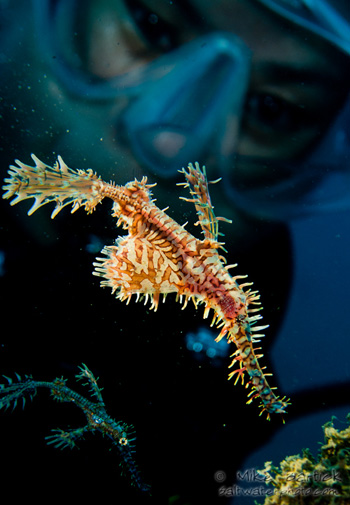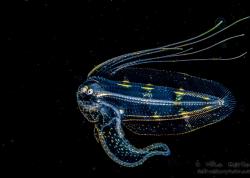5 Critters You Must See in the Indo-Pacific

A diver takes a close look at an Ornate Ghost Pipefish (Solenostomus paradoxus)
The Indo-Pacific region is famous among divers for its diversity of marine life. There are countless photo subjects, but 5 critters stand out from the rest and are frequently referred to as the Holy Grail. They are often as difficult to photograph as they are to find. Inconsistent sightings, conditions and even the ornate nature or size of the creatures can test your dive skills, photography technique and patience.
#5 Bobbit Worms (Uenice aphroditois)
The carnivorous polychaete of the sand flats is a somewhat clumsy yet wicked subject. A nocturnal feeder, the bobbit worm is most active after sunset. A calcified set of jawbones at the top of the worm’s head is your first clue that this guy means business. Chemical receptors and tentacles also come into play when the bobbit worm hunts. An ambush predator, the bobbit worm conceals itself at sand level and snatches unsuspecting fish from the water column as they pass by. This is a real science fiction critter that can't be missed when visiting the Indo-Pacific. Read more about the bobbit worm.
Photo technique
A red filtered modeling light seems to work best as the bobbit is very light sensitive. Try to catch a series of photos showing the behavior or better yet, switch it over to video.

#4 Hairy Frogfish (Antennarius striatus)
The hairy frogfish is actually one of my personal favorites because it tends to be a bit more sophisticated at its craft than most. But don’t let its cute appearance fool you; the hairy frogfish is a voracious predator and a rapacious foe that uses pheromones, a lure and its legendary gape strike to hunt and feed. The A. striatus uses a 3-phase technique to excite and antagonize their prey, while conserving their own engery.
Phase 1: The hairy frogfish releases pheromones in a chum slick, which drifts with the current to excite nearby fish who think a meal is nearby. The curious fish, unaware of the danger that awaits, follows the pheromone slick upstream.
Phase 2: As the unsuspecting fish comes closer, the hairy frogfish switches to more visual stimulation technique by deploying its oversized wormlike lure, creating an irresistible temptation for fish, shrimp and squid of all sizes.
Phase 3: The strike zone is someplace you wouldn’t want to be if you’re in frogfish territory. Once the victim is within range the frogfish unleashes its lightning-fast gape strike. It’s so fast the victim has no chance to react, and unlike the bite strike technique of pelagic feeders, the frogfish drops its lower jawbone with such force that it actually pulls its prey right into its mouth. The intestinal sphincter muscle extends forward, crushing its victim before the digestion process begins. On occasion the froggy will spit its victim out and attempt to re-align it for easier entry into their digestive gullet. They are often seen feeding on prey larger than themselves.
Photo technique
I like using a shallow depth of field to produce a composition different from many traditional images (around f/5.6) and to fill the frame with the subject. The hairy appendages melt away nicely into the background with the ambient light. Hairy frogfish aren’t going to swim away, so be patient and wait for the right shot. They are light sensitive so minimizing strobe flashes will yield more authentic behavior.

Read more about types of frogfish, or the hunt for the rare pink frogfish.
#3 Cephalopods
Blue-Ringed Octopus, Mimic Octopus, Wunderpuss and Flamboyant Cuttlefish are often the most fun to engage, as they are also the most intelligent of marine creatures. The Wunderpus and Mimic both enjoy feeding on and playing with mantis shrimp, and as a result they tend to share the same habitat. Hunting on open sand flats, they will move from hole to hole in search of their next meal. Both are fast moving, animated creatures that are quick to morph colors and shapes.
The blue-ringed octopus can appear out of nowhere at a dive site, sending photographers into a frenzy. On wall dives, in coral, rocks, the shallows or deep water, the BRO tends to be more nomadic than its cousins. And although all octopuses contain various types of venom for hunting, the blue-rings contain TTX, a potent venom created in its stomach and delivered via saliva into its victims. The venom is powerful enough to kill multiple fully grown men with just one bite. Read more about the blue-ring octopus and the wunderpus octopus.
Flamboyant cuttlefish can be seen walking about on the substrate using two forward arms, and rarely swim unless threatened. The colors are generally muted until the cuttlefish is excited, when it flashes its flamboyant colors to ward off predators or to communicate. The skin tissue is also reported to contain TTX, so contact with a flamboyant cuttlefish is highly discouraged. Cephalopods are the most intelligent invertebrates on earth, however they have a physical limitation that requires them to rest often. Their hemoglobin wont carry much oxygen as other critters, and most have two hearts to help pump the blood through their body. This is a big advantage for underwater photographers.
Photo technique
Take advantage your subject’s playful and dramatic nature by filling the frame for expressive photos and turn the camera to shoot portraits.





#2 Ornate Ghost Pipefish (Solenostomus paradoxus)
Ornate Ghost Pipefish hold a top position in this short list and for good reason; they are both unique and beautiful. The Syngathidae family (which includes seahorses, leafy sea dragons and pipefish) shares a fused jaw feature that places them into a single category with over 200 species. Ghost pipefish are quite different from these brethren and only recognize 6 species in their family.
The most obvious difference is body shape. Common pipefish resemble pencils while ornate ghost pipefish have a downward facing head, allowing them to assume strategic hunting posture with a view from above. The common pipefish spends its lifecycle on the substrate and is only occasionally seen free swimming. In contrast, the OGP rarely uses the substrate and instead hunts from above, often mimicking its surroundings, which include sea grass, algae, halameda or soft coral. It’s believed that the ornate ghost pipefish kicked off the recent “critter craze” and I believe it.
All ornate ghost pipefish begin their lives as males, but some change into females as they grow from juvenile into the sex phase. The males tend to stay smaller whereas the female grows in size to accommodate and care for her eggs, which will develop in a pouch between her lower caudle fins. Eggs are often present with the female as she carries her them in hopes of mating once the right male has been found. The planktonic juveniles will begin their life as pelagic drifters before settling just above the substrate to grow into adults.
Photo Technique
The ornate ghost pipefish lends itself to portrait photo composition. Proper side lighting will pull the color through the photo and help to isolate your subject from the background. Adding the human element with a model is also nice.


#1 Rhinopias (Rhinopias/Scorpaenidae)
Rhinopia images are much coveted and top the list of many serious photographers when traveling to the Indo-Pacific. The Rhinopia easily holds its golden heavyweight belt in the top 5 critter list for several reasons.
The first is that they often appear as a drab dull brown or greenish color before exploding with vibrant color the millisecond any light touches their patterned skin tissue. Their bold colors and body textures become immediately obvious when photographed with strobes, adding to the intrigue of these amazing creatures. But even with this unique appearance it’s the odd behaviors that give them so much personality. Swimming forward with their face dragging on the bottom they appear to be injured or helpless fish, enticing their prey to investigate. Once the curious victim is close enough, the Rhinopia consumes its prey with its massive bucket mouth gape strike. Masters of deceit. Despite the Rhinopia colorations, textures and popularity they remain extremely elusive. This is evident when one is found, because the news sends shockwaves through the local underwater photo community.
Read more about the Rhinopia.
Photo Technique
Rhinopias are a mid sized critter and images need strong depth of field. Lens selection is primary for me. I like the Tokina 10-17 fisheye on a small port, Sigma 28-80 zoom behind my macro port or my 40mm Nikon lens (Canon 35mm) to include the entire animal. Pay close attention the eyes and compressed facial features, this is a very unique critter.


Publisher's note - where to find these critters
Check out our list of muck-diving sites to find out great areas to see these critters. Anilao is one of our favorites, but Lembeh, Milne Bay PNG and Ambon are other great choices - but not the only ones.
Conclusion
The top 5 critters picks is just the tip of the iceberg in what can be found when diving the Indo-Pacific. The region is both bio-diverse and dense with these critters year round and makes for a fantastic photo safari for both macro and wide-angle. Now go out and have an adventure!
Further Reading
RECOMMENDED ARTICLES
SUPPORT THE UNDERWATER PHOTOGRAPHY GUIDE:
The Best Service & Prices on u/w Photo Gear
 Visit Bluewater Photo & Video for all your underwater photography and video gear. Click, or call the team at (310) 633-5052 for expert advice!
Visit Bluewater Photo & Video for all your underwater photography and video gear. Click, or call the team at (310) 633-5052 for expert advice!
The Best Pricing, Service & Expert Advice to Book your Dive Trips
 Bluewater Travel is your full-service scuba travel agency. Let our expert advisers plan and book your next dive vacation. Run by divers, for divers.
Bluewater Travel is your full-service scuba travel agency. Let our expert advisers plan and book your next dive vacation. Run by divers, for divers.

































